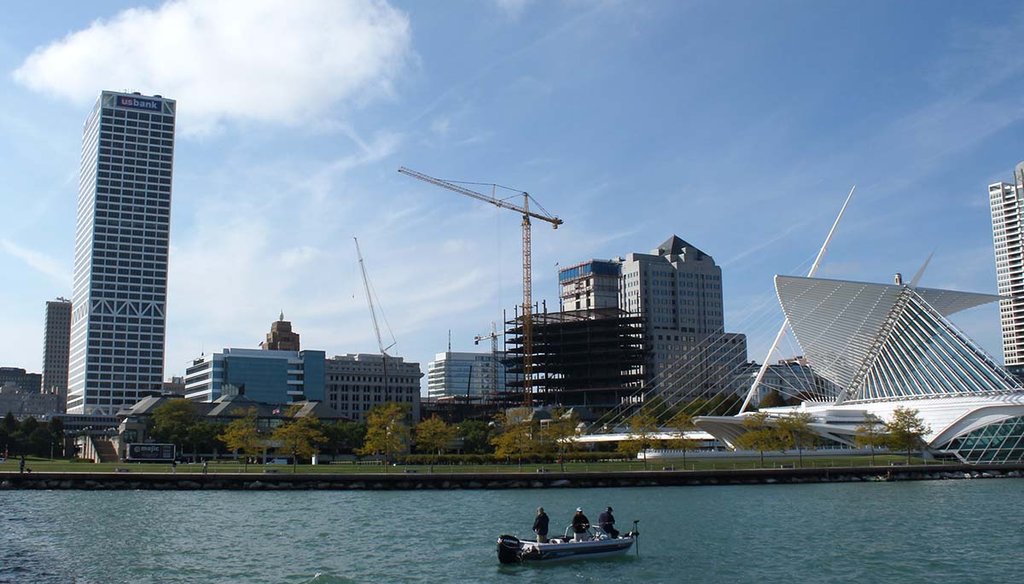Stand up for the facts!
Our only agenda is to publish the truth so you can be an informed participant in democracy.
We need your help.
I would like to contribute

A view of Milwaukee’s skyline looking west from Lake Michigan, seen in November 2015. (AP)
Wisconsin tourism is having a big moment. But what goes into calculating economic impact?
If Your Time is short
-
The $25.6 billion number includes $15.7 in direct visitor spending, plus indirect effects such as wages being spent in local economies.
-
Not all counties benefit equally from tourism in Wisconsin, but all saw at least some increase from 2022 to 2023.
-
It’s common for Wisconsin to set a tourism record every year, but the pandemic caused a dip from which the state has largely recovered.
It’s not a stretch to say Wisconsin tourism is having a moment.
Season 21 of "Top Chef," which just finished airing, gave viewers a glimpse of Wisconsin’s traditions. Business boomed at Frank Lloyd Wright's Taliesin in Spring Green after it was featured in an episode.
In a few weeks, the Republican National Convention will blanket Milwaukee, bringing thousands of delegates, politicians, staff and media who will spend money on entertainment, hotels and restaurants.
And don’t forget about next April, when an estimated 240,000 visitors will come to Green Bay and surrounding cities for the National Football League draft. An economic impact of $94 million is the early projection.
That boom isn’t lost on Wisconsin politicians, especially Democratic Gov. Tony Evers, who has frequently hyped up a "record-breaking year" for tourism in posts on X, the site formerly known as Twitter.
"Wisconsin saw another record-breaking year for tourism, with a historic $25 billion economic impact in 2023," Evers posted June 11. "That blows 2022's record year out of the water."
On June 22, Evers also called out "Wisconsin's record-breaking year for tourism" and credited outdoor recreation opportunities.
PolitiFact Wisconsin was interested in these numbers, because tourism will surely continue to be a hot topic in Wisconsin in the months ahead.
$25 billion is clearly a large number, but what goes into the formula to generate that economic impact? Is it spread throughout the state, or only in cities? And how does it compare to past years?
In short, is Evers right that it’s record-breaking? Let’s take a look.
Outside report calculates visitor spending and other variables to reach $25 billion number
The $25 billion number Evers is referring to comes from the Tourism Economics Report, which is available on the Wisconsin Department of Tourism website.
The report was created by Tourism Economics — a company of global advisory firm Oxford Economics — not the state itself.
The methodology explains the firm used a model to trace the "flow of visitor-related expenditures through the state’s economy and their effects on employment, wages, and taxes."
Visitors were considered people who stayed overnight on a trip or traveled more than 50 miles to a destination. Multiple data sources were used, such as from surveys and the U.S. Bureau of Labor Statistics.
With that said, let’s take a closer look at how they calculated the $25 billion total impact.
A large portion of that number — $15.7 billion — comes from direct visitor spending on things like lodging, food and beverage, retail, entertainment and transportation.
Then there’s about $4.6 billion in what’s called supply-chain effects, such as needing to purchase more from food wholesalers and utilities.
Finally, there’s $4.7 billion in "induced impacts" — which refers to wages that are generated directly or indirectly by visitor spending and spent in the local economy.
That gives a picture of what goes into the $25 billion: It’s more than just the raw amount that visitors are spending in Wisconsin.
Is that impact equally felt in the state?
The tourism department said all of Wisconsin’s 72 counties saw an increase in their total economic impact number from 2022 to 2023. A spreadsheet of county-level data confirms that.
The top five counties with the highest economic impact, in millions, were Milwaukee, Dane, Sauk, Waukesha and Brown.
Interestingly, popular tourism destination Door County ranked eighth at $620 million, far below Milwaukee’s $4.17 billion.
The counties with the lowest economic impact from tourism were Menominee, Florence, Pepin, Forest and Lafayette. Those ranged from $6 million to $29 million in impacts.
The counties that saw the highest growth in their total economic impact from 2022 to 2023 were Monroe, Menominee, and Green Lake. They saw increases from 10 to 11 percent each.
Bottom line: All counties experienced growth in 2023, though some counties clearly benefit more from tourism than others.
Records often set each year, with COVID-19 pandemic as an exception
Let’s go back to the part of Evers’ claim about 2023 being a "record-breaking year."
The tourism department has said the $25 billion last year broke a record, surpassing the previous record of $23.7 billion set in 2022. That increase is above the rate of inflation, too.
There’s a history of setting a new tourism record every year, at least under normal circumstances.
In 2017, the economic impact was about $20.6 billion, then $21.6 billion in 2018, the Oshkosh Northwestern reported. In 2019, the economic impact was $22.2 billion, according to a WPR story.
Then came the COVID-19 pandemic. In 2020, the economic impact dropped significantly to around $17.3 billion, then increased 21% to $20.9 billion in 2021, according to the department.
Clearly, the tourism industry has been rebounding from COVID-19. The report says that "key indicators point to the normalization of Wisconsin’s visitor activity in 2023."
But some of those indicators haven’t quite caught up to pre-pandemic levels. Those include employment directly supported by visitor activity, and local and state tax revenues.
Still, previous reports show that 2023 was a record-setting year for tourism. That economic impact number appears to steadily rise and set new records each year, with the onset of COVID-19 as an exception.
And it certainly won’t be a surprise if Wisconsin sets another record in 2024, when the effects of "Top Chef" and the RNC are accounted for.
Our ruling
Evers claimed Wisconsin had a "record-breaking year" for tourism in 2023.
The $25 billion total economic impact did set a record in 2023. Setting a new record each year is common, though COVID-19 caused a dip that the state has largely recovered from.
That impact isn’t felt equally in all communities in Wisconsin; some counties benefit far more from tourism than others. But all counties saw at least some increase in their totals from 2022 to 2023.
And don’t be surprised if the state Department of Tourism announces another huge increase in 2024.
We rate the claim True.
Our Sources
Milwaukee Journal Sentinel, People are flocking to Frank Lloyd Wright's Taliesin after it was featured in 'Top Chef', April 26, 2024.
Milwaukee Journal Sentinel, 'Most we ever spent in a city': What the largest delegation plans to do in Milwaukee for RNC, June 24, 2024.
Green Bay Press Gazette, Five reasons Green Bay hosting the 2025 NFL draft is 'a really big deal' for Wisconsin, May 24, 2023.
X. Gov. Tony Evers, June 11, 2024.
X, Gov. Tony Evers, June 22, 2024.
Tourism Economics, The Wisconsin Visitor Industry - 2023, May 2024.
Wisconsin Department of Tourism, County by County Spreadsheet, 2024.
Wisconsin Department of Tourism, Gov. Evers, Department of Tourism Announce Wisconsin Tourism Sees Another Record-Breaking Year, June 11, 2024.
Oshkosh Northwestern, Wisconsin tourism is flourishing; its economic impact reached $21.6 billion in 2018, May 19, 2019.
Wisconsin Public Radio, 2019 Was The Best Year In Recent History For Wisconsin Tourism, Then Coronavirus Hit, May 5, 2020.
Wisconsin Department of Tourism, Wisconsin Tourism Surges in 2021, June 8, 2022.
Browse the Truth-O-Meter
More by Hope Karnopp
Wisconsin tourism is having a big moment. But what goes into calculating economic impact?
Support independent fact-checking.
Become a member!
In a world of wild talk and fake news, help us stand up for the facts.















































